


As one of the most hated figures of the 20th century, Hermann Goering is usually remembered as a rotund, almost ridiculous figure, who possessed an insatiable addiction to fine living, rare artworks and a reputed addiction to drugs. His links to the very highest positions amongst the Third Reich hierarchy and the heinous crimes they committed dictate that history has nothing but loathing for this man, and indeed many figures inside Germany had no time for this brash and arrogant character. With all this being undoubtedly true, how did Goering manage to rise to a position of prominence in Germany and have such an influence on the history of the Second World War?

When you have the accepted picture of a red faced, overweight, white uniform wearing Hermann Goering firmly in your mind, it is difficult to think that he could have ever been anything other than this person. In actual fact his formative years saw a slim, active young man, with piercing blue eyes and a strong, square jawline, who possessed extremely high intelligence and a fearless, if a little reckless nature. An accomplished rock climber, with little regard for his own personal safety, the young Goering had a fascination for the military and was determined that he was destined to do his duty.
Born in 1893, Hermann Goering was aged 21 when the First World War broke out. At this time, he was already a serving 2nd Lieutenant in the German Army and reputedly told his sisters, ‘You can be sure that I will do credit to our name’ – he proved to be true to his word. When he reported for duty at Prince Wilhelm No.12 Infantry division, at Muhlhausen, in German occupied Alsace-Lorraine, he thought that he would be straight into the action, as the French border was only one mile away. Unfortunately, due to the unstable nature of the front line at that time, the unit was ordered to retreat in to Germany and it would be many weeks before he could get involved in the war. As the German Army was planning a major offensive against the French lines, they desperately needed information on enemy troop concentrations in the area and detailed mapping information was needed - Goering was charged with obtaining this vital information. Indeed, his early career was to be very much involved in the gathering of important reconnaissance information, a duty that he undertook with uncommon enthusiasm and great dexterity.
Usually operating in extremely advanced positions, Goering and his men were placed in particularly dangerous situations – not only were they at risk of being attacked by the enemy, but they were often also subjected to heavy shelling from their own artillery. Conditions were difficult for the reconnaissance units, as they were forced to find cover wherever they could, but often in the open countryside, with the cold, damp conditions, leaving many suffering from exposure. These conditions were to lead to Goering being hospitalised with a severe attack of rheumatism in both legs, which proved to be a very difficult time for the all-action Goering, who felt like something of a failure, as the war was carrying on without him. Despite his depression, this time in hospital was to prove to be significant in shaping his immediate future. Becoming increasingly frustrated by his inactivity, Goering heard that his good friend Bruno Loerzer had been transferred to a local air training school – he contacted him and asked him to visit him in hospital. His friend duly called and regaled the recuperating Goering with stories of aviation daring and the excitement of powered flight – the young Goering was totally captivated and thought of nothing else, over the coming weeks.
On his discharge from hospital, Goering made the air training unit his first call and immediately filled in papers to be transferred there – unfortunately for him, on the very day that his application was turned down, his friend Loerzer qualified as a pilot and was posted to an operational Luftstreitkrafte unit. This was not acceptable to Goering and his disregard for authority came to the fore once more and rather than follow orders and report to his infantry unit, he followed his friend to Darmstadt airfield and persuaded him to use him as an aerial observer. His friend agreed and for a time, Goering operated as something of a freelance air gunner/observer in the 25th Field Air Detachment of the German 5th Army, under the command of Imperial German Crown Prince Wilhelm. All of this was against the express orders of his army commanders.
For his serious indiscipline, a military court sentenced Goering to 3 weeks confined to barracks and a return to his army unit, but he simply ignored the sentence and never actually served the punishment – luckily for Goering, the war was proving to be something of a distraction.
Throughout the spring of 1915, Goering spent his time serving operationally as a reconnaissance observer in Loerzer’s aircraft. They were proving to be a highly successful team, photographing and sketching accurate images of enemy troop positions and gun emplacements – Goering had a real flair for aerial photography, at a time when aerial reconnaissance was of critical importance on the Western Front. His images were extremely clear and if enemy aircraft tried to disturb them in the execution of their duty, he would use his revolver to drive them away, showing little regard for his personal safety and displaying extreme valour. When delivering the photographs the pair had gathered to military commanders, the pair were often ordered to attend the planning meetings and give details of their mission in person and provide first hand information of the enemy positions they saw – the enigmatic Goering was enthusiastic, if a little unorthodox during these meetings and his personality quickly endeared him to senior officers.
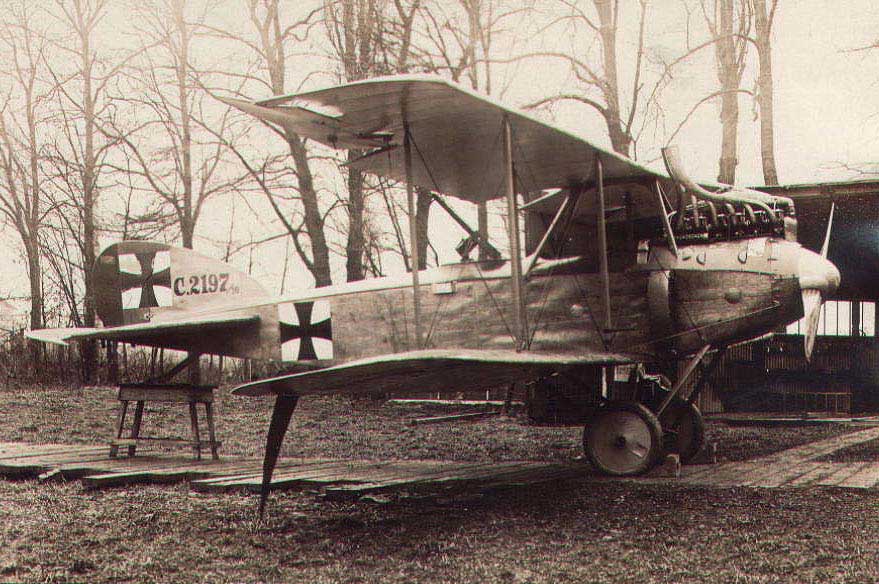
Early Albatros reconnaissance aircraft on the Western Front
One reconnaissance mission that said much about the character of the young Hermann Goering took place in the skies above the Western Front during the spring of 1915. Flying a two seat Albatros reconnaissance aircraft, the pair were charged with obtaining vital photographs of enemy troop positions, but their task was made more difficult by the type of aircraft they were using. The lower wing of the aircraft was directly below the observers position, which made obtaining photographs directly below the aircraft incredibly difficult – Goering had a daring solution. He waited until the aircraft was almost over the target, before climbing out of the aircraft and hanging over the side, with just his feet and lower legs preventing him from falling to his death. Clutching the camera in both hands, he instructed the pilot to bank the aircraft over and sideslip over the target, allowing him to take a clear and unobstructed photograph, but also leaving him in an extremely perilous position. He obtained beautifully clear pictures, even changing the photographic plates between each shot, whilst almost every gun on the Western Front was firing at them! This incident quickly circulated around the German Air Force and Goering was christened ‘The flying trapezist’, gaining great notoriety in the process.
Goering was an excellent observer, but still had a tendency for insubordination – he did not suffer fools gladly. When directing German artillery fire on to enemy positions, gunners were strongly rebuked if they did not follow his direct firing instructions, irrespective of rank of the gunners. He also learned morse code, so that he could give instructions to commanders whilst still in the air and was one of the first aviators to send this type of fire control message. The reconnaissance flyer was quickly becoming an endangered airman, as the day of the fighter aircraft was dawning – Goering decided that he had been an observer for long enough and applied for pilot training, but not before his work as a reconnaissance observer had been recognised with an iron cross, 2nd class – whatever he was engaged in, he was determined to be the best.
The toast of every aircraft mess on the Western Front, the flying trapezist longed to become a fighter pilot and join this exclusive group of celebrated aviators. In June 1915, he reported to Freiburg, where he was to begin his flight training course and realize his dream of becoming a fighter pilot. From the outset, Goering proved to be an excellent student, performing faultless take-off and landings, much to the annoyance of his fellow students. In fairness, he should have been quite proficient, having observed his friend Bruno Loerzer perform numerous take-off and landings over the past few months and his friend was an excellent pilot. Flying over the beautiful rolling hills of the Black Forest, Goering displayed a particular flair for aerobatics and managed to pass his course with an impeccable record – unlike many of his fellow students, he didn’t have a single prang during the course. By October 1915, he had qualified as a fighter pilot and was posted with his friend Loerzer to Jagdstaffel 5 on the Western Front, just as the Allied armies had launched a huge winter offensive – the pair were going to be kept extremely busy.
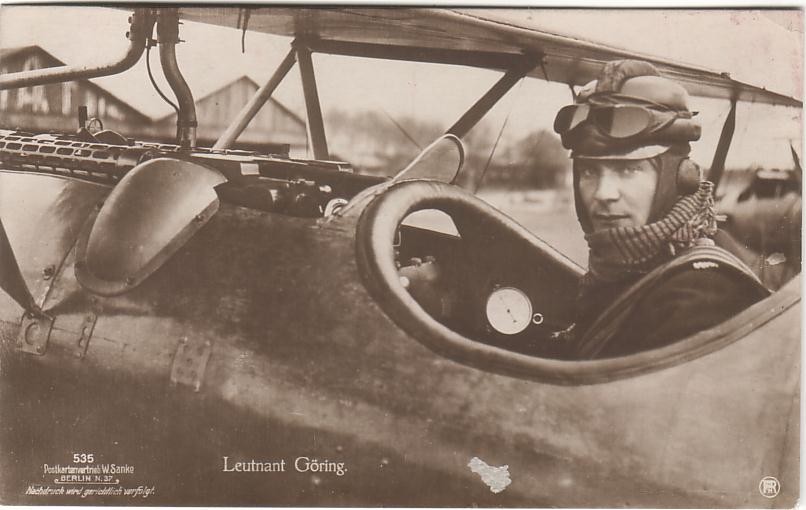
Qualified pilot Hermann Goering
We have mentioned the friends Goering and Loerzer on a number of occasions now and it is worthwhile looking at the contrasting characters of the two men. When flying together in a reconnaissance capacity, the pair made an exceptional team – Loerzer was an extremely accomplished pilot, but as the effectiveness of the mission was very much judged by the quality of the imagery obtained, the determination and fearless nature of Goering ensured that the pair were held in high regard. As the careers of the two men developed, their personal character traits continued to be distinctive features of both their operational effectiveness and their flying style in general. Without doubt, the impetuous and over confident Goering had no problem with his general flying abilities, but in combat situations, his eagerness to get involved in the fight and take a toll of the enemy, could lead him into some very dangerous and easily avoidable situations.
In direct contrast to this, Loerzer was a shrewd tactician and would quickly and effectively survey the situation at hand, before committing himself to the battle. He had a much more calm and considered approach to his flying and would not let excitement, or thrill of combat, influence his decision making - his flying capabilities were not in question and although he was also keen to make his mark in combat, he would try to make sure that he achieved his victories, whilst retaining the best chance of getting home. As the pair would regularly fly together, the fact that Loerzer was more stable in combat was to prove of great benefit to his impetuous friend, as he was forced to extricate Goering from some sticky situations, on a number of occasions. Of his good friend, Goering said, “We are bound together by something stronger than chains, Loerzer and I. I know that in my hour of need, he will never let me down.” Bruno Loerzer was to end the war as the eighth most effective air ace in the German Air Force, with 44 victories.
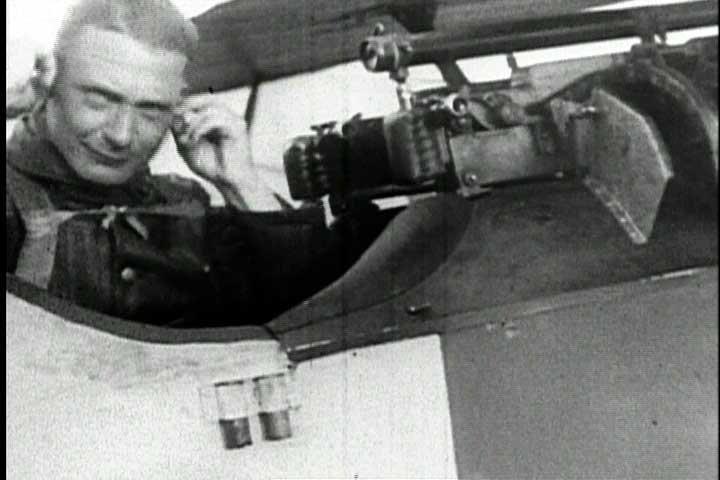
Pursuit pilot Hermann Goering sat in his office
As a newly qualified pilot arriving on the Western Front, Goering was extremely keen to enter the fray and challenge himself against Allied pilots. He was to gain his first victory on 16th November 1915, whilst flying a reconnaissance mission over Tahure, following the end of the second battle of Champagne. Despite the end of this battle, German units in the vicinity were still on high alert and military commanders were keen to obtain updated information on enemy troop position. Flying his trusty Albatros C.1 (C486/15), Goering and his observer were gathering the information they needed, when a French Air Force Farman MF.7 reconnaissance aircraft attacked them. In the ensuing struggle, the Farman was shot down and importantly for the crew, German ground units saw the engagement and the Farman falling from the sky. On return to their home aerodrome, the news of their success had already been received and the pair were celebrated for their achievement - Goering had his first victory.
Over the coming months, Goering enjoyed limited success, whilst continuing to increase his flight time over the Western Front. The impetuous nature we discussed earlier was never too far from showing itself whilst in the air and on one occasion in November 1916, it was to almost cost his life. This fascinating account tells much about the character of Hermann Goering and had this situation turned out differently, it could have had a dramatic impact on the future of European history.
On 2nd November 1916, Goering was flying a mission in his Halberstadt D.II fighter, in the final days of the Allied Somme offensive. He was tasked with shooting down any enemy aircraft attempting to cross the German lines and was flying in company with two other aircraft. Over the preceding few weeks, there had been reports of a large Allied bomber flying extremely effective strike missions over the Somme area and scoring some notable successes with their bombing attacks. Goering had been desperately searching for the aircraft for many days and was determined to gain the notoriety of bringing down this ‘fat crate’.

The huge Handley-Page bomber hunted by Goering
Flying at 2,000ft on a misty November day, Goering spotted a very large aircraft below him and without hesitation, he dived down to attack the beast. The aircraft he was reported to have attacked was one of the largest aircraft in the world at that time – the massive Handley Page H.P 0/100 twin engined bomber, which had a 100ft wingspan and would have certainly made for a juicy target. Goering’s fighter closed on the bomber and he opened fire on the rear gunners position – the Allied airman was hit and his gun fell silent, but a second airman took the position and returned fire. Goering again silenced this gun, before moving on to the mid gunners position and then to the left engine of the mighty bomber, which started to flame. The bomber began to fall away and glide toward the relative safety of the Allied lines, but just as Goering closed for the kill, his aircraft was raked by a hail of bullets from behind – he had failed to notice a large number of Allied fighters high above his original position and he was now quite simply, a sitting duck!
Taking a step back for just a moment, as Goering spotted the large British bomber, he failed to signal his intentions to his fellow airmen and assess this situation in the manner that his friend Loerzer would have done. Had he searched the skies for the complete situation, he would have seen a large number of Allied fighters flying 1,500 feet above them, obviously using the low flying bomber as bait for the German airmen. The other two German pilots spotted what they claimed to be 20 plus fighters above them and immediately turned for home, obviously feeling that discretion was the better part of valour, leaving Goering to fend for himself!
Back to the incident developing above Combles, Northern France and Goering was taking multiple hits from the attacking fighters. He was massively outnumbered and very much on the run, but the large number of attacking fighters behind him was to actually work in his favour – the Allied airmen were getting in each other’s way, in their desperation to claim the victory. Goering’s aircraft took a hit to the fuel tank and fuel was spewing out everywhere – he was trying everything he knew to shake off his attackers, whilst attempting to engage his reserve fuel tank at the same time. Yet another hail of bullets hit his aircraft, on the wings and engine cowling – a bullet grazed his leg and another was to ricochet off the instrument panel and hit him in the hip. This was a significant wound and he began to bleed profusely. Goering had just one chance to survive – he put his aircraft into an almost suicidal dive towards the ground and with quite a heavy mist below, his attackers immediately broke off their pursuit, probably thinking that they had done their work. Goering managed to pull the aircraft out of the dive, but he was now struggling to remain conscious, due to the heavily bleeding wound and was now flying just above enemy lines – if his situation was not already bad enough, he began to take heavy fire from the Allied lines. Flying at treetop height and drifting in and out of consciousness, Goering managed to fly over the German lines, just as the engine finally stopped and he put the Halberstadt down in the grounds of a cemetery, next to a church, which was acting as a field hospital. It is said that this stroke of luck saved Goering’s life, as the hip wound was bleeding profusely and the backrest of his seat had broken loose and was sticking in the open wound – he was dragged from the aircraft and immediately taken to the operating table. Had he not had access to this immediate medical attention, it is argued that Goering had no chance of surviving this incident and even accepting the huge stroke of luck landing near a field hospital, the operating surgeon still felt that the severity of the wound and the sheer loss of blood would dictate that this young man would never take to the air again. He would definitely have the addition of a large scar on his right hip for the rest of his days.

A downed aeroplane - a regular sight on the Western Front
This amazing incident did much to increase the profile of the young Hermann Goering and was certainly an impressive display of valour and devotion to duty, but this could have been exactly what Goering had intended. There is no doubting that combat took place on this day and that Goering sustained an injury to his right hip, but the rest of the details may well have been embellished somewhat. With regard to the large Handley Page bomber, these monstrous aircraft were in service, but in the Dunkirk sector, which was far away from where Jasta 5 and Hermann Goering were flying. It is much more likely that the aircraft was a single engined BE.2, which was definitely operating in the area of this incident. Secondly, it is much more likely that there were no more than six British Nieuport fighters giving chase to Goering, although these would have still been quite difficult fighting odds to contend with. Finally, the fortuitous field hospital landing may also be a little fanciful and it could actually be that Goering made it back all the way to his home airfield. Whatever the truth of the matter, it makes for a very interesting read and why should we ever let the truth get in the way of a damn good story!
The story could have been yet another indicator of the flawed character of Goering – endangering himself and his aeroplane in a futile gesture, which would surely have been against orders. His injury saw him spending four months away from duty, which although will have frustrated Goering immensely, is in stark contrast to the operating doctors assessment of the severity of his injury. In a further display of direct insubordination, he was ordered to report to Boblingen for a period of convalescence, but instead he made straight for the front line and his friend Bruno Loerzer, who had been given the command of a new fighter unit (Jagdstaffel 26), at Darmstadt – his excuse was that he could not find the town on the map.
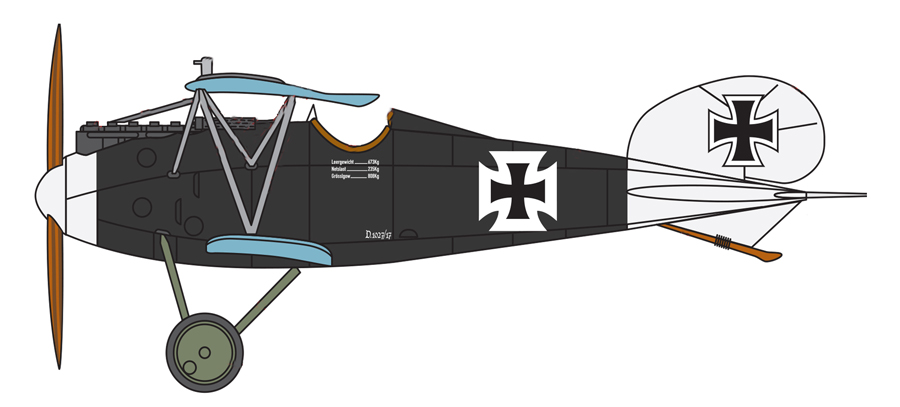
Profile image of the latest Corgi Albatros announcement
Returning to combat over the Western Front, Goering began to settle in to the role of fighter pilot and his victory score began to rise. By 10th May 1917, he had seven victories to his name and he was soon promoted to Staffelfuhrer of Jasta 27. This relatively new unit was equipped with much older aircraft, which were almost obsolete at this stage of the air war – Goering quickly earned the respect of his men, by using his persuasive nature and lofty connections to secure much better aircraft for the squadron, which gave them a much better chance of success in combat. Over the next few months, Goering showed himself to be a skilled and tenacious fighter pilot, also proving to be an inspiration to the men serving with him. His victory tally continued to rise impressively and by April 1918, he had been credited with his eighteenth victory – this was to be significant in the fighting career of Hermann Goering and saw him awarded the coveted Pour le Merit medal, referred to by airmen as ‘The Blue Max’.
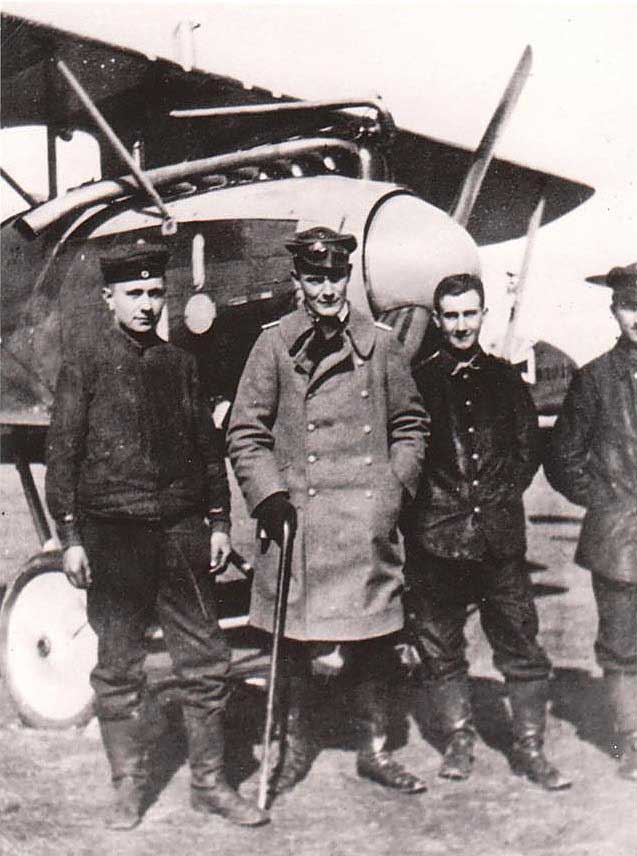
Hermann Goering with an Albatros D.V and members of Jasta 27
Perhaps the most significant event in the fighting career of pursuit pilot Hermann Goering occurred on 11th June 1918. On this date, and aged just 25 years old, Goering was told that he would be given command of JG.1 – the famed ‘Richthofen Flying Circus’. Regarded as the most prestigious group of aviators in the world, Goering would be the third (and final) commander of this famous fighter group, but the appointment was not without its detractors. A number of 40+ victory aces had been overlooked with the appointment of Goering and the rumour within the unit was that he only got the promotion because of the connections he had in influential circles. Goering was aware of this hostility and approached the situation with his usual aplomb – addressing the men for the first time, he paid fulsome credit to the heritage of this famous unit and the capabilities of his new pilots. Displaying his full repertoire of infectious enthusiasm and enigmatic personality, he soon won the men over and the question was never raised again. Although he was only to score one further victory whilst commanding ‘The Flying Circus’, the tide of war had already turned in favour of the Allies, but Goering still managed to make his mark. In the final days of the war, he was to show one last act of defiance and petulance, which was very much the character of the man. His superior officers told him that he must fly his aircraft to Strasbourg and surrender the entire unit to French forces there. The reason behind this instruction is rather interesting – at the time, the Flying Circus were operating the excellent Fokker D.VII fighter, which is generally regarded as being the most capable German fighter aircraft of WWI. This superb fighting aircraft had an impressive kill-to-loss ratio and was a feared adversary of Allied airmen on the Western Front. In fact, the Fokker D.VII was regarded so highly by the Allies, that the terms of the armistice specifically dictated that all D.VIIs had to be surrendered to the Allies - this is the reason for the fly to Strasbourg order that so enraged Goering.
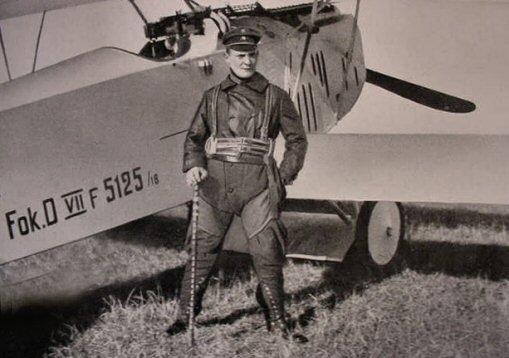
Addressing his men, he said, “I am afraid that we must comply with the order, but we have an opportunity to make sure that the French don’t get what they are expecting!” His men took the hint and when the world famous Richthofen Flying Circus arrived at Strasbourg, they virtually crash-landed their aircraft, rendering them little better than useless. Goering regarded this incident as a successful mission and was one final act that said much about the character of this infamous man.
When discussing the early career of Herman Goering, it is difficult to be impressed by any of his many creditable achievements, specifically because of what we know he was to be involved in just a few short years later. Indeed, it has been quite difficult to complete this article, as I obviously wanted to make it an interesting read, but most definitely did not want to be seen in any way to distance this man from the horrendous acts he committed during WWII. What I did want to show was how totally different the young Goering was from our recognised perception of one of the most infamous figures in European history. It is true that the overweight, pompous figure of WWII is the accepted image we all have of Hermann Goering, but this is contradictory to the handsome and daring young man, who climbed into the cockpit of his Luftstreitkrafte fighter aircraft on the Western Front, in 1916.
Many Aerodrome readers will have handsome die-cast aviation collections, with many models either on display, or fermenting in the loft. Others may only have a few models to their name, but whichever is the case, I will bet that most will have one of the magnificent 1/48th scale World War One aircraft models in their collections. These superb models have become some of the most collectable models in the hobby and a great many previous releases are now almost impossible to obtain, without paying significant premiums on the secondary market. I am particularly taken with the larger 1/48th scale for single engine fighters, as they allow the manufacturer to make a more accurate rendition of the actual aircraft and benefits the collector in allowing him to have a much better representation of the size and power of the real aeroplane, when displaying their model.
With a large number of 1/48th scale WWI models in the Aviation Archive range released so far, there is no doubting the popularity of these models. With the first models appearing back in 2007, I am often asked if there is a chance of seeing new tooling additions to this impressive range, which has clearly struck a chord with die-cast collectors all over the world. I am sure that new models have been considered over the years and I will certainly try to make sure that I raise the question with the right people, at every available opportunity. I don’t usually like to delve into the strange world of the secondary market, but many of the previous WWI model releases are now so difficult to find, that when they do appear on the market, they tend to command significantly higher prices than the original RRP, which really does act as an indicator of the popularity of these delightful little models.
To link in with the subject of this week’s blog, the latest Corgi catalogue release announcement included news of a magnificent future release in the 1/48th scale WWI aviation range, which features one of the distinctive aircraft flown by Hermann Goering, during his wartime flying career. AA37807 will be the latest release in the Albatros D.V range and seems destined to be incredibly popular – this is an absolute beauty! Goering flew various versions of the Albatros during his combat career on the Western front, from the two seat Albatros B.I reconnaissance aircraft, to the definitive Albatros D.V single seat fighter, which is represented by this release. Some of the most distinctive and attractive paint schemes ever used on military aeroplanes appeared on the Albatros aircraft of WWI and this latest announcement is definitely one of the very best. It represents a machine flown by Goering whilst flying with JASTA 27, from Iseghem aerodrome, in Belgium, between the dates of 16th June and 31st October 1917 and one in which he was to claim victories over Allied airmen. As far as the WWI air war is concerned, Goering is a significant figure, rising to become commander of the feared Richthofen Flying Circus and ending the conflict with 22 aerial victories – this will make AA37807 a very popular release and collectors are advised to reserve their example at the earliest opportunity.
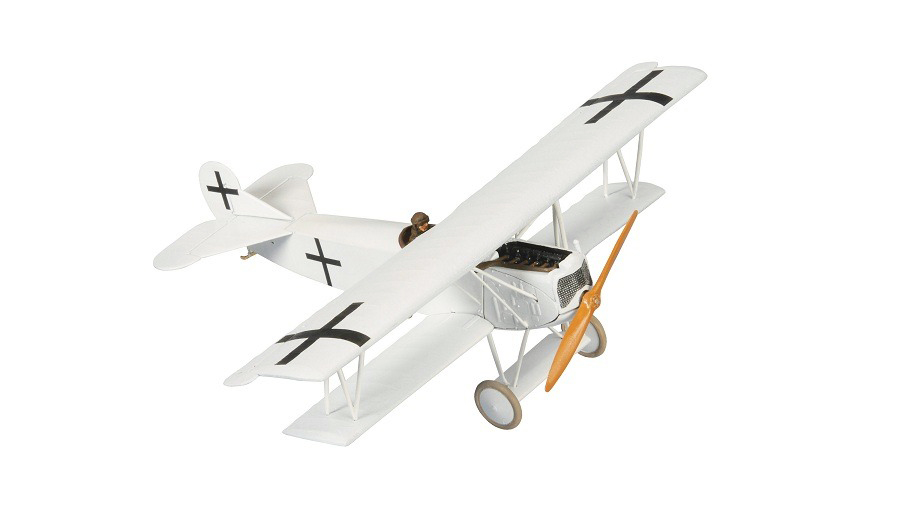
The previously released Hermann Goering Fokker D.VII
The 1/48th scale range can already boast an example of one of Goering’s WWI aircraft within its ranks – AA38901 is his all white Fokker D.VII, which was one of the last aircraft he was to fly operationally. The D.VII was an excellent aircraft and proved to be the finest German fighter of the war, with an excellent kill-to-loss ratio – unfortunately for them, it was a case of too little, too late! This distinctive model marks an aircraft that Goering flew whilst he was in command of the ‘Richthofen Flying Circus’ and features an interesting tooling modification. As Goering continued to be troubled by arthritis and the hip injury he suffered earlier in the war, he found it particularly difficult getting in and out of the cockpit of his aircraft. A field modification, which cut away a section of the fuselage, to allow Goering easier access to his aircraft was authorised and this feature is incorporated into this impressive model. Unfortunately, it is extremely difficult to obtain one of these highly collectable models now, as they totally sold out many months ago - if you are lucky enough to have this model in your collection, you will definitely want to make sure that you add the recently announced Goering Albatros as well, as they will make for a very interesting and attractive display.
That is another Aerodrome completed and I really hope that it has been an interesting read. You can discuss this week's blog on the Aerodrome Forum, and if you have any comments, questions or suggestions for future editions, please feel free to let us know on Facebook or Twitter using #corgiaerodrome.
Thank you for your continued support.
Michael
© Hornby Hobbies Ltd. All rights reserved.
Archive images licensed under Public Domain via Wikimedia Commons.